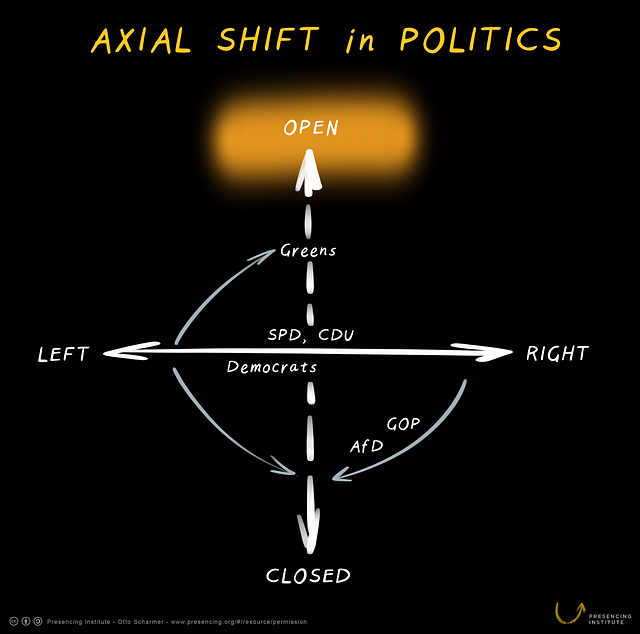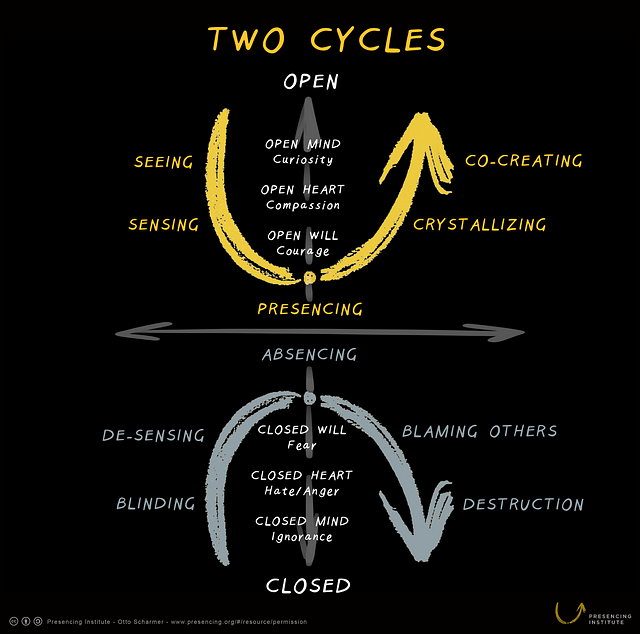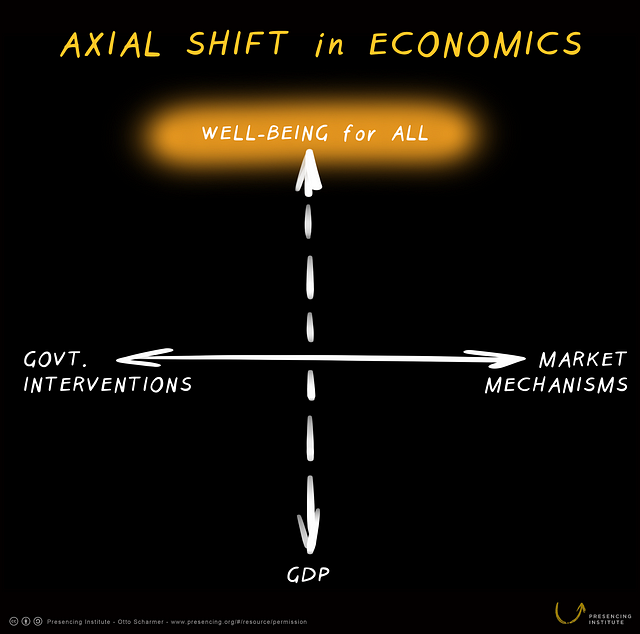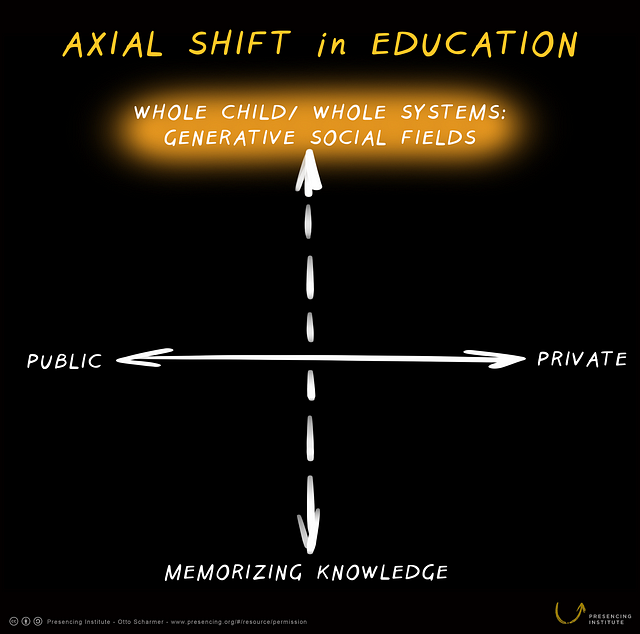The midterm election results demonstrate that the United States continues to be divided and moving to the extremes of left and right. This widely shared analysis, I believe, is wrongheaded, because it looks at a 21st-century reality through a 20th-century lens (i.e., left vs. right). Instead, we are dealing with a profound axial shift that is redefining the coordinates of the political, economic, and cultural space.
By axial shift, I mean a new system of coordinates that shapes the intellectual discourse. The axial shift is not only at display here during the US midterms, but also around the world, as the recent election results in Brazil, Germany, and Italy, among other countries, demonstrate. In all these places, the main axis of political conflict is no longer primarily between left and right, as it was in the last century, but between open and closed.
And this shift is not limited to politics. The coordinates of the economic discourse are shifting from the old debate between more government vs. markets, to more GDP vs. well-being. A third axial shift concerns the educational system, where we see the debate of public vs. private shifting to memorizing old knowledge vs. whole child, whole systems learning through cultivating generative social fields.
These three axial shifts are replacing the traditional 20th-century public discourse with a new axis of conversation and thought that supports a new avenue for societal renewal. The campaign strategy of the Democratic Party during the 2018 midterms, as I explain below, is a clear example of missing a historic opportunity by looking at a new situation through an old lens.
The Political Shift
The shift of political coordinates from left vs. right to what New York Timescolumnist David Brooks calls open vs. closed is happening in many countries. Figure 1 maps the old 20th-century line of conflict along the horizontal axis and the emerging 21st-century polarity along the vertical axis.

Figure 1: The new political coordinates
The distinction that underlies the horizontal axis is well known: the “left” tends to respond to problems by increasing government services, while the “right” tends to respond to the same issues by promoting individual initiative — in short: more government vs. more market.
But what about the vertical axis? Through Donald Trump and Brazil’s newly elected president Jair Bolsonaro, we know one part of that axis very well. “Closed” means a mindset that amplifies the triad of Fear, Hate, and Ignorance. It’s a mindset that manifests in the form of five behaviors: blinding (not seeing reality); de-sensing (not empathizing with others); absencing (losing the connection to one’s highest future); blaming others (an inability to reflect); and destroying (destruction of nature, of relationships, and of self).
The playbook of these five behaviors has reshaped politics over the past couple of years. Not because any of these behaviors are new. But because these behaviors are now weaponized with social media mechanisms such as micro-targeting and dark posts that increase our isolation in digital echo chambers and that amplify these toxic behaviors on levels not seen before. To illustrate, let’s look at a few recent examples.
The appointment of Brett Kavanaugh to the US Supreme Court: not interviewing witnesses (blinding); not empathizing with the victims of sexual assault (de-sensing); contaminating the legitimacy of the Supreme Court with a partisan mindset (absencing); blaming “the mob” and “the Clintons” (blaming others); and putting the country on a path to civil war (self-destruction).
Mass shootings in schools, religious institutions and public places: not looking at the real issues, such as gun laws (blinding); not empathizing with the real victims (de-sensing); claiming that the student activists are paid actors (absencing); blaming the victims for not defending themselves (blaming others); and putting the community on a path toward civil war (self-destruction).
Climate change: not accepting scientific evidence (blinding); not empathizing with the increasing number of victims, particularly in the global South (de-sensing); dismantling the Environmental Protection Agency (absencing); actively undermining the credibility of climate science and climate scientists (blaming others); and pulling out of the Paris Agreement (putting civilization on a path toward self-destruction).
That’s the Trumpism playbook. It has been surprisingly effective. Bolsonaro copied much of it in the campaign that swept him into office. Like Trump, he shows contempt for women, nature, minorities, and the rules and principles of democracy. So why did people vote for him? For the same reasons Americans voted for Trump and the British voted for Brexit. Because they believe, with some real justification, that the old system failed them. They prefer the one candidate that promises to disrupt the current system and to ‘drain the swamp.’
If Trump is the symptom and not the problem, what then is the problem? It is the lack of a real political, economic and cultural alternative that would activate the enormous potential for the upper part of the vertical axis (figures 1, 2).

Figure 2: Two Social Fields: The cycle of co-creation (presencing) and the cycle of destruction (absencing)
Most young people that I know would place themselves outside and above of the left-right axis onto the upper half of figures 1 and 2. Two thirds of this group voted Democratic during yesterday’s midterm elections. The same phenomenon was visible in the two recent state elections in Germany. These elections (in the ultra-conservative Bavaria and in Hessen) resulted in historic losses of the government coalition among the center-left social democrats (SPD) and the center right conservatives (CDU), while the two main winners that emerged from the election are positioned around the vertical axis: with the anti-refugee AfD (a neo-national/neo-Nazi-oriented party) on one end, and the Green Party on the other end of the spectrum. Bavaria is to Germany what Texas is to the US: the ultraconservative South. The rise of the Green Party in that context is a remarkable phenomenon because in Germany the Greens were the only party that did not cozy up to the neo-nationalist sentiments that gave rise to the AfD. It reminds us of Beto O’Rourke refreshing run for a senate seat in Texas (and his very narrow loss to Ted Cruz) and demonstrates that the collective potential for activating the upper part of the vertical axis is much bigger than what see manifest today.
A few main points in conclusion:
First, the rise of Jair Bolsonaro (Brazil), Viktor Orban (Hungary), Jaroslaw Kaczynski (Poland), Matteo Salvini (Italy), Recep Erdogan (Turkey), Vladimir Putin (Russia) and Rodrigo Duterte (the Philippines) demonstrates that (a) Trumpism, defined as the lower end of the vertical axis, is not limited to America, and (b) that it’s closely related to the social media enabled amplification of fear, hate, and ignorance (figure 2).
Second, the rise of the Green Party in Germany, of a new generation of diverse women representatives into the US Congress as well as the victories of President Alvarado in Costa Rica and President Jokowi in Indonesia demonstrate that across the planet, people can respond to their dissatisfaction with the current political establishment in different ways: by opening the mind, heart, and will (through curiosity, compassion, and courage) instead of closing these capacities (through ignorance, hate, and fear) — see figure 2.
And third: the conflict around the vertical axis between closed and open is not new. Here in the US it goes back at least as far as the Civil War. In many ways that war never fully ended but has continued through various forms of institutionalized racism and exclusion (Jim Crow laws). Of the 26 senators that represent the 13 secessionist Southern states of the former Confederacy in the US Senate today, only 5 are Democrats, 21 are Republican. Of the 38 senators that represent the 19 Northern (Union) states in the Senate today, only 9 are Republican, 27 are Democrats (and two are independent). Clearly, closed versus open is not new. What’s new today are three conditions: that the issue is now playing out globally; that we have only one decade left to transform our economies and societies in line with the planetary boundaries for sustainable development; and that social media are amplifying the toxic behaviors (i.e., the cycle of absencing) on levels not seen before.
Lastly, while the GOP under Trump has moved from its traditional conservative core to fully embracing the neo-national populist (and white supremacist) views on the low end of the vertical spectrum, we see the Democrats still stuck in the middle, debating whether to move more left, more center, more populist, or more upwards on the vertical spectrum. Most of the campaign focused on traditional progressive themes (healthcare services) while missing out on putting forth a more daring new narrative for the American civilization (upper end of the vertical axis).
The Economic Shift
Likewise, we see a shift of economic coordinates reshaping the discourse about how to run our economies. Throughout the 20th-century this discourse tended to focus on different views of how to best ignite the cycle of economic growth. One school of thought favored market mechanisms (liberal and neoliberal), and another favored government intervention and more active macro-economic steering (Keynesian and neo-Keynesian). The new discourse of this century is emerging around another axis and school of thought — namely, whether the growth paradigm is part of the problem and should be replaced by a post-growth paradigm that focuses on well-being for all.

Figure 3: The new economic coordinates
In reality, of course, the old discourse and the old paradigms do not simply go away. So the new coordinates of our current public economic discourse actually feature both of these dimensions as depicted in figure 3. The horizontal axis is based on the well-known discourse between more government-centered and more market-centered ways of running the economy.
The vertical axis, however, is based on the empirical finding that, in developed economies, more GDP does not tend to translate into more well-being. So, if GDP (as a measure of output, not outcomes) is not a good indicator of economic progress, is there a better alternative? That’s where the new conversation starts.
Some alternative indicators currently discussed include (1) Bhutan’s Gross National Happiness (GNH) indicator, the HDI (Human Development Index) of the UNDP, and (3) an emerging set of measurements that track the progress on implementing the 17 Sustainable Development Goals (SDGs) adopted by the UN General Assembly in 2015.
A few observations on the new economic coordinates:
First, even though many of the old economic paradigms crashed and burned in 2008, much of that thinking is still alive and kicking across capitals and institutions. The mainstream economic discourse is still firmly in the grip of the horizontal axis of 20th-century economic thought.
Second, with regard to the vertical axis, we see more emphasis and articulation around the lower part of it (i.e., the rise of economic nationalism), while the upper part remains, if articulated at all, the exception, not the rule (examples: Bhutan, Costa Rica).
Third, where do we see the upper part of the vertical axis already growing and blossoming today? In many local communities. Local and regional multisector initiatives on the city, or state level often show the characteristics of the upper vertical axis. That bottom up-movement that is seeding and prototyping new collaborative and economic forms is what Tyler Norris of the Wellbeing Trust calls the “most important least well-told story” of our time.
Lastly, the only chance to actually implement the 17 Sustainable Development Goals (adopted in 2015) by 2030 is to massively strengthen and help evolve that movement by creating new infrastructures for collaboration and democratic participation from the local levels up, in order to generate well-being for all, i.e., in order to upgrade the operating system of our economy from ego-system awareness to eco-system awareness (from the lower to the upper parts of the vertical axis).
The Educational Shift
One way to capture the new educational coordinates is through noticing the changed meaning of the digital divide. The real digital divide is not between children who have access to the internet and those who don’t. The real digital divide, writes New York Times columnist Naomi Schaefer Riley, is “between children whose parents know that they have to restrict screen time and those whose parents have been sold a bill of goods by schools and politicians that more screens are a key to success.” According to a 2011 study at Northwestern University, minority children watch 50 percent more TV than their white peers.
“The digital divide was about access to technology, and now that everyone has access, the new digital divide is [about] limiting access to technology,” said Chris Anderson, the former editor of Wired magazine. This is particularly evident in Silicon Valley, where the private Waldorf School (with extremely restrictive access to screen time) is popular with Silicon Valley tech executives, while the nearby public Hillview Middle School focuses on its 1:1 iPad program.
While much of the old discourse on education revolved around public vs. private schools — i.e., left vs. right — the new discourse seems to focus more on the type of learning: memorizing figures, formulas, and facts vs. whole child approaches to learning and creativity that revolve around generative social fields while integrating head, heart, hand (figure 4).
 Figure 4: The new educational coordinates
Figure 4: The new educational coordinates
As I look at the current landscape of education through the lens of the coordinates in figure 4, three observations come to mind.
First, most of the current activities and discourse are still firmly in the grip of the old axis of thought (public vs. private, etc.).
Second, the whole artificial intelligence (AI) revolution that is going to reshape the way societies operate will predominantly replace jobs based on the skills that we learn on the lower half of the spectrum (memorizing figures, formulas, and facts). The result will be to further reorient human activity and value creation toward the upper half of the spectrum (human compassion, empathic human services, collective creativity, deep listening, generative dialogue, collective presence, holding the space, letting go, and letting come).
Third, while we all know good individual schools that venture into the upper half of the learning spectrum, there are hardly any examples of larger school systems that have done so. I say hardly any because the Finnish (and the Nordic) educational system(s) probably qualify as the sole exception to this rule — even though the key players in Finland emphasize that they are only just beginning their own transformation journey.
The Most Important Blind Spot of Our Time
What do the axial shifts in politics and in the economy have to do with the shift in education and learning? Everything. The 20th-century discourse was essentially about a difference in ideology. As the historian Yuval Noah Harari points out in his book 21 Lessons for the 21st Century, in 1938 you had 3 ideologies: fascism, socialism, liberalism. In 1968 that number was down to 2 (socialism, liberalism). In 1998 the number was down to 1 (supposedly the end of history). But today, in 2018, that number is down to zero. No ideology. Just Me-Me-Me…
If the difference on the vertical axis is not ideology, what is it? It is consciousness, that is, the quality of how we connect. The shift from the lower two quadrants to the upper two is a shift in consciousness from ego-system awareness to eco-system awareness, from me to we.
The good thing about Trump, populism, and ego-system awareness is the energy and the initiative that is being actualized. The bad thing (or its limitation) is its narrowness: the ego is so small. It is no match for the real complexity in our age of interdependence. Complexity and interdependence require an opening: of the mind, of the heart, of the will. When we continue to engage with this opening process — with all its challenges around the voice of judgment, the voice of cynicism, and the voice of fear — we go through a profound mindset shift from ego to eco. We begin to see a situation not only from our own point of view, but also from the viewpoint of all the other players in our eco-systems.
That opening process — and the new awareness-based methods and tools to facilitate it at scale — is probably the most important and least well supported process of our time. It involves a movement in the making that, due to the noise that surrounds us, is often missed and yet deserves our highest quality attention.
What You Can Do Now: Societal Transformation Lab
We need to tell the story of that opening process. Countless individuals, groups, and organizations are facing challenges that require them to methodically move from ego- to eco-systemic ways of operating — i.e., to move upward on the vertical axis. But in that journey, they often feel unsupported and alone. What is missing is an enabling, supporting infrastructure that provides methods and tools of awareness based systems change and that helps the current generation of change makers to connect with their peers across systems, sectors, and geographies.
In order to provide this missing element of enabling infrastructure, my colleagues and I at the Presencing Institute are teaming up with multiple global networks and organizations from across sectors that are working to activate the upper part of the vertical axis at scale. This new initiative and infrastructure is called Societal Transformation Lab. Launching in early 2019, it will function as a multi-local innovation platform for teams and organizations that are working toward profound innovation in their own organizations and eco-systems.
We are launching a new website to recruit partners for this initiative. The Lab is free, online-to-offline, and will bring together change makers from across the world. Teams and organizations will have access to s.lab’s online platform, which will be designed to enable change makers from across sectors, systems, and geographies to support each other’s learning, leadership and prototyping.
If you have a team (or an organization) that is working toward these goals, we invite you to visit our site and apply to join the lab today.
The Societal Transformation Lab is a shared effort from dozens of organizations and networks to go beyond analysis and collaborate around collective action in ways that transform our old civilizational structures through bridging the ecological, social, and spiritual divides. Join us with your organization and team if you feel drawn to this purpose.
Great thanks to my colleagues Kelvy Bird (figures) and Adam Yukelson for commenting on and co-creating this piece.





